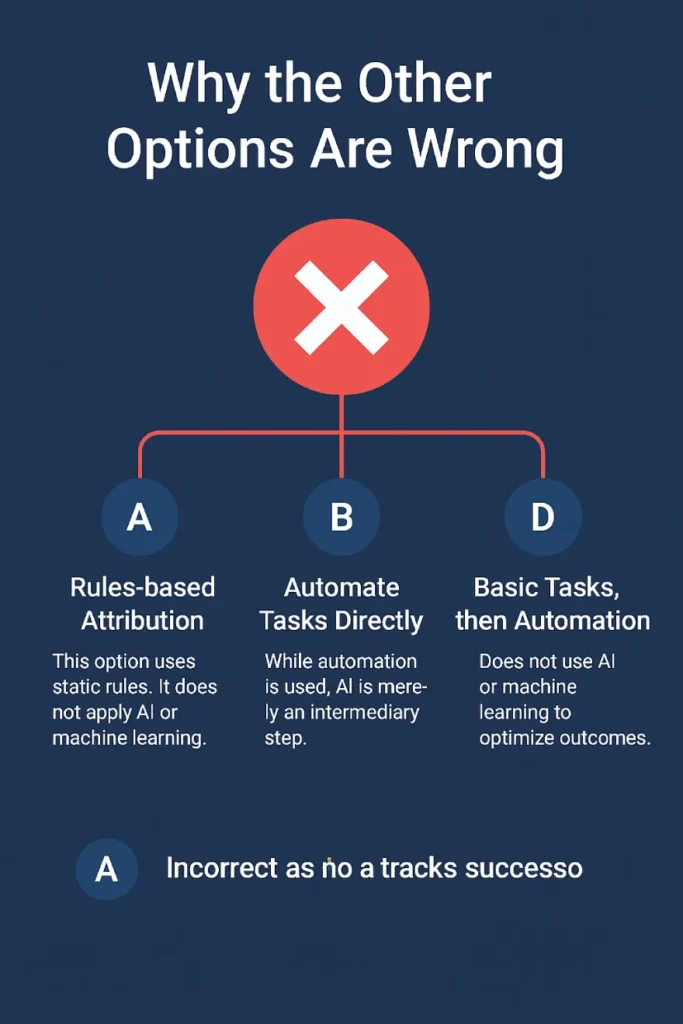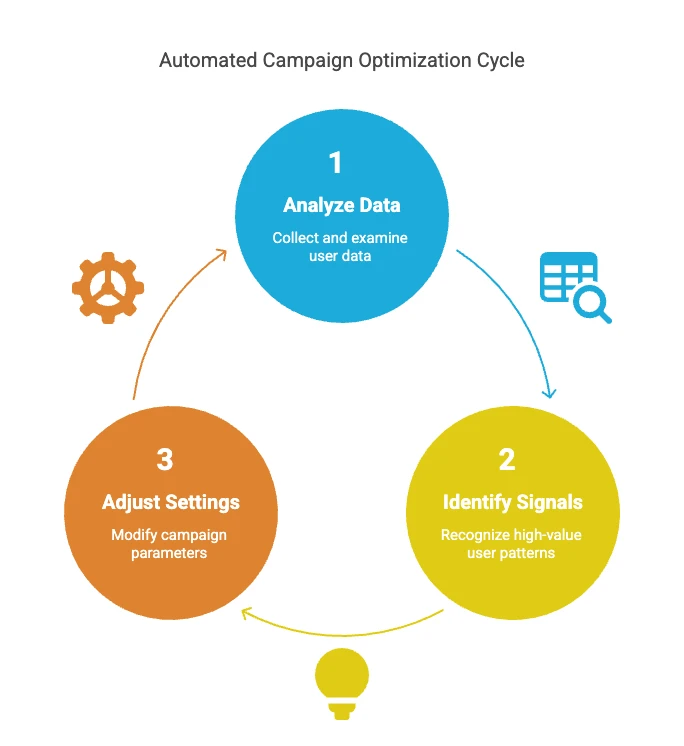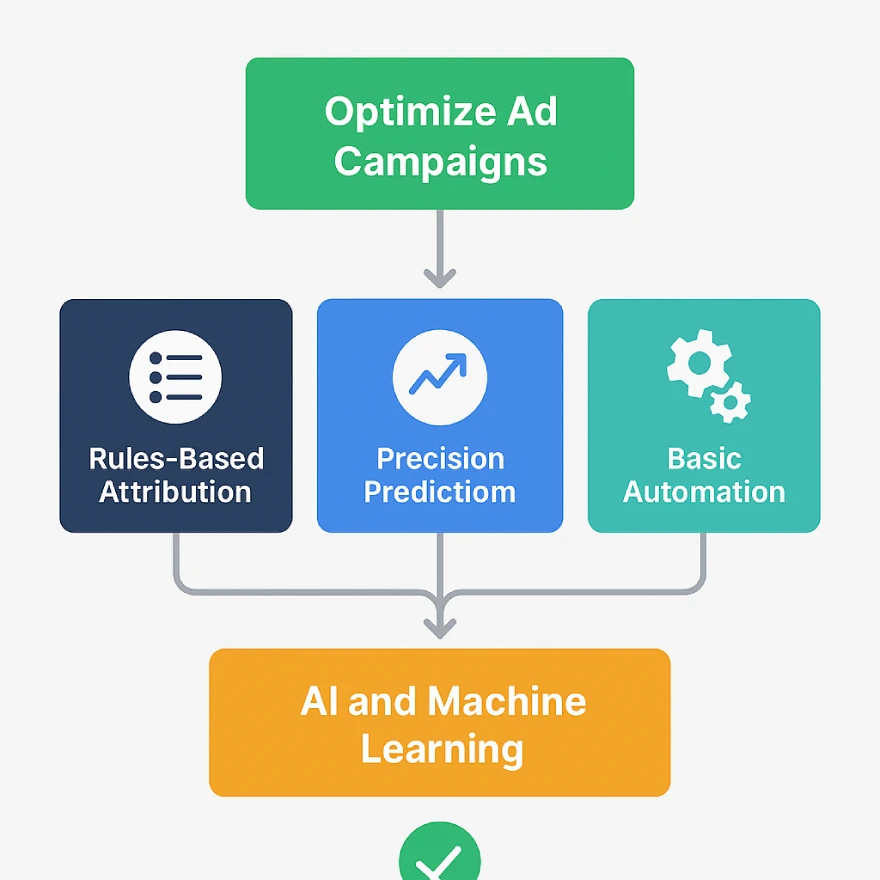Curious about how easily you can pass the Google Ads Measurement Certification? In this post, I’ll break down a real exam question and walk through each option, explain the correct one, and clarify why the others are wrong. If you stick through to the end, you’ll not only master this question but also understand how AI shapes real ad performance.
So, no delay—let’s get to the main point!
Question and Correct Answer
What does it mean when ad campaigns are optimized by Google’s AI?
- They use rules-based attribution and software to achieve desired AI-friendly outcomes to influence the process and avoid optimizing for those outcomes.
- They use data-driven attribution to automate tasks., and the process has all the necessary data.
- They use AI and machine learning technology to predict what will achieve the best conversion outcomes to optimize bidding, creative, etc.
- They use basic tasks, then software, to automate those tasks, and the process has all the necessary data.
The Correct Answer is: ✅ They use AI and machine learning technology to predict what will achieve the best conversion outcomes to optimize bidding, creative, etc.
Why is the correct answer right?
Google’s AI doesn’t just automate; it learns from data. It uses machine learning to analyze patterns, test outcomes, and adjust campaigns in real-time. When campaigns are AI-optimized:
- Google predicts what users are likely to convert
- It adjusts bids based on conversion potential
- It tailors creative, audiences, and even ad placement
- This entire process runs 24/7, improving over time
This predictive intelligence makes Google Ads smarter and more efficient. That’s what makes Option C the most accurate.
Why are the other options wrong?
Understanding why the incorrect options fail is just as important as knowing the right answer.

🔻 Option A: Rules-Based Attribution Misrepresents AI
This misrepresents how AI works. Google’s AI doesn’t rely on fixed rules—it adapts dynamically based on user behavior. “Rules-based attribution” implies static logic, while real AI uses continuous learning. Also, “AI-friendly outcomes” is a vague and misleading term; it implies manual manipulation rather than predictive autonomy.
🔻 Option B: Attribution Is Not Optimization
“Data-driven attribution” helps determine which clicks contributed to a conversion. While it is part of measurement, it doesn’t optimize bidding, audience targeting, or creative. This option confuses analysis with action. AI optimization is predictive and active, not just analytical.
🔻 Option D: Basic Automation Isn’t AI
This option describes simple automation (e.g., scripts or task scheduling). While helpful, it lacks the intelligence and adaptability of true AI. Google’s AI doesn’t just automate; it decides. It adjusts settings based on predictive modeling, not static instructions.
Real-Life Exam Example
Let’s see how this plays out in the real world.
Scenario:
Maria owns an online jewelry shop. She runs a Google Ads campaign and sets up Smart Bidding using Target ROAS (Return on Ad Spend).

What Google’s AI does:
- Analyzes Maria’s past 30 days of data. It looks at clicks, conversions, devices, times, locations, and user behavior patterns.
- Identifies high-value signals. The system notices that:
- Mobile users
- On weekdays
- At around 7 PM
- From New York City
are most likely to make purchases.
- Adjusts campaign settings automatically. It:
- Raises bids for those users
- Prioritizes showing Maria’s best-performing creative
- Decreases bids for low-performing segments
Outcome:
Maria gets better ROAS, her CPA (cost per acquisition) goes down, and she spends less time tweaking her ads manually.
Comparison
This table shows why Option C is the only choice that reflects true AI optimization:
| Feature | Option A | Option B | Option C ✔️ | Option D |
|---|---|---|---|---|
| Predictive ML | ❌ | ❌ | ✅ | ❌ |
| Optimizes bidding | ❌ | ❌ | ✅ | ❌ |
| Learns from conversions | ❌ | ❌ | ✅ | ❌ |
| Uses rules or fixed logic | ✅ | ✅ | ❌ | ✅ |
What is AI optimization in Google Ads?
Google’s AI optimization uses machine learning models that process billions of signals across millions of campaigns. These models improve performance by:
- Predicting conversion likelihood for each user.
- Adjusting ad settings in real time for every auction.
- Learning and improving performance continuously as new data comes in.
- Maximizing results even when budgets are limited.
Unlike basic automation, AI doesn’t just execute tasks—it makes decisions.

Resource Links
- Google Ads Smart Bidding
- Understanding Machine Learning in Google Ads
- Campaign Optimization by Google AI
FAQs
Q1: Is Smart Bidding part of AI optimization?
Yes. Smart Bidding uses real-time machine learning to adjust bids automatically based on conversion likelihood.
Q2: Can I override AI optimization settings?
Yes, but it’s not recommended. Manual settings disable Google’s predictive learning. You lose the advantage of real-time optimization.
Q3: How long does Google AI take to “learn”?
It usually needs 7–30 days to gather enough conversion data, depending on your campaign size and volume.
Q4: What if I don’t have enough conversions yet?
Start with Maximize Clicks or Target Impression Share, then shift to Smart Bidding when you hit at least 30 conversions/month.
Conclusion
If your campaign is AI-optimized by Google, you’re letting the system analyze thousands of data points, predict who will convert, and dynamically adjust your bids, audiences, and creative—all to drive better performance.
That’s why Option C is the right answer. You now fully understand how Google AI shapes ad campaign success in both certification and practice.
Finally, I can say that if you are ready, you can take the exam on Skillshop – Google Ads Measurement Certification. If you want more real exam questions and answers like this one, which have already been covered, follow along. I’ll be breaking down more Google Ads Measurement Certification exam questions with full solutions in the next posts on Google Ads!

